It’s possible that I shall make an ass of myself. But in that case one can always get out of it with a little dialectic. I have, of course, so worded my proposition as to be right either way (K.Marx, Letter to F.Engels on the Indian Mutiny)
Thursday, November 25, 2021
Black, Caribbean and African-descent nurses in British Columbia face frequent “entrenched and pervasive” racism and discrimination at work that is causing trauma and fuelling health inequities for Black and racialized patients, according to a new survey.
In the survey as well as group meetings conducted by the Coalition of African, Caribbean and Black Nurses in BC, nurses described frequent workplace bullying and harassment from colleagues, patients and their families. They described some co-workers refusing, before the pandemic, to touch objects previously handled by Black colleagues.
One nurse described being physically assaulted by a colleague after the nurse informed the colleague that they’d taken the nurse’s chair.
“Everyone who came to our group meetings had different experiences of racism and discrimination,” said Ismalia de Sousa, a nurse and PhD student at the University of British Columbia school of nursing who helped found the coalition in 2020.
But many shared experiences, like being dismissed by superiors, having few opportunities for promotion or being scapegoated for mistakes made by non-Black colleagues, came up again and again, de Sousa said.
Ninety-three per cent of survey respondents were women, and three-quarters were born outside Canada, meaning intersecting sexism, racism and xenophobia further worsen the harm they experience.
“Those experiences have significant impacts for respondents’ personal and professional lives, and have long-lasting traumas too,” de Sousa added.
Now the coalition is calling for transformative action to support Black nurses and end anti-Black racism in health care that is affecting both staff well-being and patient care and outcomes.
“As nurses, student nurses, academics and researchers, we have an ethical duty to safeguard human rights, justice, equity and fairness,” reads a Wednesday open letter from the coalition addressed to the provincial government, health authorities and regulatory colleges for nursing.
“This is why we call on you to heed the B.C. Human Rights Code and work collaboratively with us to find solutions that put an end to racism and racial discrimination and its associated emotional and physical impact on our members, non-members and the public.”
The coalition was founded by a group of concerned nurses in the wake of the pandemic’s first wave and the public reckoning with racism in health care, and anti-Black racism following the murder of George Floyd in Minneapolis.
Racism and discrimination are not new for Black nurses who’ve been living with them for years and decades, stressed de Sousa, but the events of 2020 shone a light to make them unignorable.
In B.C., the extent of anti-Black racism in health care and its effects is obscured by the lack of race-based data collection and missing research on the specific experiences of Black nurses in the provincial context.
There is a lot of data from elsewhere in the world on anti-Black racism experienced by health-care workers, de Sousa said, but it can’t be considered an exact indication of what is happening in B.C.
Meanwhile, there are very few Black people, let alone nurses, in senior leadership positions in health authorities in B.C. Respondents said this is a direct result of managers being unwilling to invest or train Black nurses for higher positions or to progress in their careers.
“Some of these ideologies and beliefs are deeply rooted in history, for instance the idea that Black people are uneducated,” de Sousa said, noting for many years Black women were barred from attending nursing schools in Canada. “And these beliefs are still manifested, sometimes unconsciously, in the ways people treat and perceive Black nurses.”
For the nearly half of surveyed nurses who were trained outside Canada, like de Sousa, barriers to registration in Canada also contributed to poor mental health or feeling helpless to report discrimination during practicum settings.
It’s also difficult always being the first Black person to do something or the only one in the room, said de Sousa. “That’s the importance of mentorship and seeing someone in a leadership position who looks like you and thinking you could be that person.”
This lack of support or promotion for Black nurses impacts patient care as well, particularly for Black patients who may not feel respected or heard by care teams they can’t see themselves in.
“In certain positions of power, if those people are not representing the people for which we care, then we won’t have health-care practice that represents everyone and that caters for everyone and that is taking into consideration every individual,” said de Sousa, “but we will have inequitable health-care policies and certain groups will remain invisible.”
The coalition hopes, like the In Plain Sight report on anti-Indigenous racism in health care, that the survey’s establishment of the extent and impacts of racism can spur action from government and health-care authorities.
In 21 recommendations, the coalition calls for senior officials dedicated to anti-racism work in every health authority, mandatory anti-racism training for all employees and enhanced policies against racism and discrimination in the workplace.
They also want a commitment to hire more Black nurses into leadership positions by 2024, a review of treatment plans and criteria that differ by race, and the establishment of a centre led by Black experts and community-builders to study causes and solutions to health-care inequities for Black people in B.C.
Barriers for internationally trained nurses to practice in B.C. should be removed, and more resources should be made available for immigrant and newcomer physical and mental health care.
“We urge everyone to recognize that while our skin colour is rooted in genetics, our experiences in society are not,” reads the letter. “Our experiences are manifestations of the deeply racist divisive societies we live in [that] we must all work together to dismantle.”
Moira Wyton, Local Journalism Initiative Reporter, The Tyee
A new landmark study shows most Canadian newsrooms remain overwhelmingly white even as immigration continues to redefine this country’s demographics, resulting in much public lament over the lack of diversity in the media.
Described as “historic” in terms of its scope and reach, a new race- and gender-based study from the Canadian Association of Journalists (CAJ) has found that “almost half of all Canadian newsrooms exclusively employ white journalists.”
“The typical Canadian newsroom is not representative of the Canadian population,” the final 17-page report, released Nov. 25, states.
In an email statement, CAJ president, Brent Jolly, told New Canadian Media that “while these numbers do not tell a complete story, they do provide a first glimpse at the makeup of Canadian newsrooms from coast to coast to coast.”
The report, conducted between November 2020 and July 2021, invited the editors-in-chief of 636 radio, television, digital and print news outlets to respond, out of which 147 sent full and verified answers. That represented 209 outlets across the country and 3,873 journalists combined. The results are mapped on out the CAJ’s website.
According to the report’s authors, it’s the first time in Canadian media history that so many organizations agreed to participate in such a study. In 1994, a national survey by the Canadian Daily Newspaper Association was sent to 82 editors, but only half responded. And out of the 18 “largest newspapers” Canadaland surveyed in 2016, only three sent answers back.
“Without a doubt, our industry is undergoing significant changes — from addressing workplace wellbeing and mental health, to uniting against online harassment and infringement on press freedoms, to being transparent about the diversity of our own newsrooms,” Jolly wrote in his email statement.
The lack of diversity has triggered a reckoning among newsrooms and journalism schools, leading to some measures adopted that have seen an increase of it.
But “(n)ewsroom managers tend to overestimate the diversity of their newsroom,” the report asserts.
According to the CAJ, those numbers are likely being inflated by a “handful of large newsrooms that employ a large number of (visible minority) reporters.” Ultimately, however, “most Canadian newsrooms tend to be whiter.”
For instance, even though 84 per cent of newsrooms employ zero Indigenous journalists, “of those that do, 74.8 per cent work at either the CBC or the Aboriginal Peoples Television Network.” Likewise, 50 per cent, 40 per cent, and 47.3 per cent of Latin, Middle Eastern and Black journalists, respectively, work at the public national broadcaster.
That means that about nine in 10 newsrooms have no Latin, Middle Eastern or Mixed Race journalists. About nine in 10 have no Black or Indigenous journalists. While Asians are “more prevalent in newsrooms,” the study found, two thirds of newsrooms employ none of them.
“By comparison,” the study states, “just three per cent of newsrooms have no white journalists on staff.”
The study found that some demographics “seem to be overrepresented when compared to the national population level,” including Indigenous (6.4 per cent of journalists compared with 4.9 per cent of the population), Middle Eastern (1.7 per cent compared with 1.5 per cent) and Mixed Race (3.1 per cent compared with 0.7 per cent).
“However, it is important to emphasize that these numbers are driven by just a few newsrooms. Ninety per cent of newsrooms surveyed have no Latin, Middle Eastern or Mixed Race journalists on staff.”
Women, who make up 50.4 per cent of the country’s population, according to 2016 census data, are also at the margins of the industry, the study found, even though the national data shows women journalists outnumbering men (52.7 per cent compared to 46.7 per cent).
That is because most women are working either part-time (61 per cent) or as interns (64.9 per cent). “Among full-time staff, women make up 50.7 per cent of journalists,” the report states, “compared to 48.9 per cent men and 0.4 per cent non-binary.”
The report also found that “84.2 per cent of all white journalists work full time compared to 63.6 per cent of Black journalists and 60 per cent of Middle Eastern journalists. Around three quarters of all Asian, Latin, and Mixed Race journalists work full time. Around 8 in 10 Indigenous journalists surveyed work full time.”
Even at the Toronto Star, which is considered a progressive newspaper often focusing on issues affecting the working class, “68.5 per cent of full-time staff are white, 22.8 per cent are Asian and none are Indigenous,” the report found, based on the Star’s own data.
“The newsroom reported between one and four Black, Latin and Middle Eastern staff.”
(It should be noted that the information is based on the Star’s own “diversified data” which did not “collect specific numbers for certain questions, like the number of Black or Middle Eastern staff, but instead collected ranges.” Therefore, the CAJ did not include their data in the final results).
When asked what they’re doing to encourage more diverse applicants to come forward, some newsroom leaders admitted “no additional steps” are being taken.
Some of the steps that were identified included targeting schools and specific associations representing diverse journalists, posting salaries and creating diverse hiring committees.
In his email statement, Jolly said despite the profession being “under increasing scrutiny and attack,” any long-term solution will require industry leaders working together, transparently.
“While it is incumbent upon all of us to find new ways to tell the complex and important stories of our time, it is also our responsibility to be up to the task of addressing our own strengths and weaknesses with thoughtful reflection.”
Fernando Arce, Local Journalism Initiative Reporter, New Canadian Media
After two days of court hearings, all those arrested from the Coastal GasLink (CGL) pipeline construction site in northwest B.C. have been released with conditions.
Last week the RCMP arrested 29 people from the construction site near Houston, while enforcing an injunction order for CGL and clearing up blockades set up by a Wet’suwet’en group and their supporters.
Among those arrested were Gidimt’en Checkpoint’s key leader Sleydo’ (Molly Wickham ) and two journalists, who were in custody until they appeared in court on Nov. 22.
Some of those arrested, including the journalists were released on Nov. 22, with conditions to comply with the injunction. All of them are expected to reappear in court on Feb. 14.
While non-Wet’sutwet’en members were told to stay out of the injunction zones, those who are Wet’suwet’en can return to hunt, fish, trap and conduct cultural practices. The journalists can return for their work, but were told to be mindful of the previous injunction and keep the peace.
Sleydo’, who was among one of the last to be released on Nov. 23, with similar conditions, was told not to be within 75 metres of any CGL worksites (as opposed to 10 metres for all the others who were arrested).
In the Nov. 23, hearing, Justice Marguerite Church of the Supreme Court of B.C., ordered Sleydo’s release on the condition she appears in court in February.
Even though CGL’s lawyer pleaded to bar Sleydo from returning to the area given past instances where she breached injunction orders, Church said the “blanket exclusion” would prevent her from exercising her constitutionally protected Indigenous rights in those areas.
Church also warned Sleydo’ that violating the conditions of her release would lead to stricter orders in the future.
Upon release, Sleydo’ said in a Facebook video statement, “This injunction has no jurisdiction on our territories, [it is] an inadequate piece of law that has been been used to violate human rights, to violate Indigenous rights, to violate Wet’suwet’en law. It’s not something that should be used when there’s issues of Indigenous land and Indigenous law in dispute with the so-called Canada and the Crown.”
She also said she was removed from her territory “illegally” and called everything that happened since their arrest on Nov. 19 a violation of human rights.
“It was a violation of our human rights, and violation of me as a Wet’suwet’en woman,” she said in the video uploaded by Gidimt’en Checkpoint.
Binny Paul, Local Journalism Initiative Reporter, Terrace Standard

Based in the Bahamas, Coral Vita is growing coral on land. - Copyright Coral Vita
By Doloresz Katanich • Updated: 23/11/2021 -
Restoring lost coral reefs and growing more climate-resilient ones is the mission of Coral Vita, a Bahama-based company.
Sam Teicher and Gator Halpern met at Yale School of Forestry & Environmental Studies and soon discovered a shared concern for the dying coral reefs of the oceans.
"I grew up in San Diego, California, where I spent as much time as I could in the ocean and in the waves and my co-founder Sam's been a scuba diver since he was 13 years old," says Coral Vita co-founder, Gator Halpern.

"Even in our relatively short lifetimes, we've been able to see how drastically the ocean environments have changed, especially coral reefs, which have collapsed all around the world."
Scientists battle to save Florida's coral reef from 'mysterious' disease
The livelihoods of one billion people depend on coral reefs, but they are dying rapidly due to climate change. In the last 70 years, half of the world’s reefs have been lost and 90 per cent are likely to disappear by 2050.
Over 25 per cent of all marine species live in coral reefs and they also provide coastal protection from waves, storms, and floods.
"Coral reefs are really the cornerstone of life in our oceans, and therefore in many ways life on our entire planet," says Gator.
What is acidification?
Ocean acidification is one of the main threats to coral reefs.
As the climate changes, the seas are warming, while also absorbing a lot of carbon dioxide from the atmosphere, turning our oceans into a huge carbon sink.
But as carbon is absorbed by the world's oceans, it changes the chemistry of the seawater so that it becomes slightly more acidic.
This combination of acidification and rising temperatures threatens the health of coral reefs, placing stress on these unique ecosystems.
This coral 'gardener' in Kenya is helping to restore an ecosystem devastated by global warming
"With our love for the environment, and for the ocean, we decided we couldn't just study the science and watch what was happening. We wanted to try to create a mission-driven company doing our best to address this issue we care so much about."
Can coral reefs be saved?
In May 2019, the pair launched Coral Vita, the world’s first land-based commercial coral farm in Freeport, Grand Bahamas. They have developed a hi-tech farming solution to grow more resistant, diverse coral and restore reefs around the Bahamas and beyond.
They grow 24 different types of indigenous coral, 50 times faster than in the wild, and breed the coral so that it is more resistant to the effects of climate change.

Coral Vita’s innovative approach to coral farming was awarded one of the first-ever Earthshot Prizes for environmental innovation, which were launched by the Royal Foundation and Prince William earlier this year.
Coral Vita was awarded the Prize in the 'Revive our Oceans' category and they will receive £1 million (€1.2 million) prize money. This will enable the company to establish a global network of coral farms and grow a billion corals each year.
FUTURISM
Wretched Garbage Planet
We’ve got a huge space junk problem — and it’s only going to get worse as more and more companies and governments launch satellites, spacecraft, probes, and even tourists into space.
While much of what we send to orbit ends up getting sucked back into the Earth’s atmosphere to burn up, much of it remains — until we figure out how to do something about it.
Things could get so bad, University of Utah professor Jake Abbott predicts that the Earth could soon start looking a lot like Saturn.
“Earth is on course to have its own rings,” he told The Salt Lake Tribune. “They’ll just be made of junk.”
Tractor Beam
According to the European Space Agency, there are an estimated 170 million pieces of space debris larger than one millimeter across already in orbit. Roughly 670,000 of them are larger than about half an inch across.
With companies like SpaceX launching their own massive constellations of broadband-beaming satellites, our planet’s orbit is busier than ever. That means we are also at a greater risk of knock-on collision events that could result in even more, smaller pieces of space junk.
Now, scientists are trying to figure out how to address the problem. Abbott believes one way to swoop up space junk could be using magnets.
By spinning up a magnet at the end of a robotic arm to create special electrical currents called eddies, individual pieces of space junk could be controlled and slowed down, as described in a recent article Abbot published in the journal Nature.
“We’ve basically created the worlds first tractor beam,” the researcher told The Salt Lake Tribune. “It’s just a question of engineering now. Building and launching it.”
READ MORE: Space pollution may soon give Earth its own rings. Has Utah team found a solution in magnets? [The Salt Lake Tribune]
More on space junk: Russia Says Actually It’s Fine That It Blew Up a Satellite, Filled Orbit With Deadly Space Junk

Biofuels investment: ExxonMobil to use algae to commercialise low-carbon fuels development
ExxonMobil to commercialise biofuels from algae technology
The US supermajor is working with biotechnology company Viridos to scale up the feedstock
US supermajor ExxonMobil has signed a joint development agreement with Viridos, a privately-held biotechnology company, to commercialise its low-carbon biofuels projects.
ExxonMobil and Viridos, previously called Synthetic Genomics, have been working together for over a decade, when ExxonMobil opened a greenhouse facility in La Jolla, California, to test algae as a biofuels feedstock.
“Our research with Viridos is one facet of our approach to help society identify and deploy the biofuels needed to reduce emissions from important sectors of the economy, including heavy duty transportation,” said Vijay Swarup, vice president of research and development at ExxonMobil.
“ExxonMobil has supported Viridos in the development of advanced bioengineering tools, and we look forward to further advancements in the research that shows potential to help society mitigate the risks of climate change.
Viridos plans for the algae biofuels to be primarily used in heavy transport, but also in aviation, commercial trucking, and maritime shipping, and hopes the renewed partnership enables other parties to access and advance Viridos’ patented technology.
“The recent productivity advances in Viridos’ technology are an opportunity to turn CO2 into renewable diesel and sustainable aviation fuels, providing an essential component for the decarbonization of the heavy-duty transportation industry,” said Dr. Oliver Fetzer, Viridos’ chief executive.
“In this next phase of the program, we intend to broaden participation and invite others to build the ecosystem required for full-scale deployment.”
Viridos’ advancements in emission-reducing biofuels come after the company has made a name for itself since its founding in 2005 through its research and genomes, specifically with transplanting the first genome, synthesising the first bacterial genome and creating the first synthetic cell.
By
Nathan Grayson
9/14/20
Sometimes it’s the small sprinkles of strangeness that stand out the most. If you had told me several years ago that 2020 would bring daily disasters of incomprehensible consequence, I probably would have believed you, because we’ve been trending in that direction for a while now. The idea of an esports organization signing a chess grandmaster, however, would have at least gotten a “Wait, what?” In hindsight, though, Hikaru “GMHikaru” Nakamura’s decision to sign with TSM makes perfect sense. Thanks to the recent efforts of Nakamura and other chess streamers, Twitch is reshaping the 1,500 year-old game in its own image.
Nakamura, 32, partnered with TSM a couple weeks ago and is one of the 20 best chess players in the world. He became a grandmaster at age 15, when most of us had barely grandmastered the art of wearing deodorant. He’s been streaming on Twitch for a couple years, but he stepped up his efforts in March and began collaborating with big-name streamers like Felix “xQc” Lengyel, among many others. Nakamura’s combination of teacherly wisdom, galaxy-brained skills, and uncommon expressiveness (relative to other, more placid chess experts) resonated with Twitch viewers. This kicked off a late-spring/early-summer chess boom that drew countless big-name streamers into its orbit.
Nakamura and other chess streamers like Alexandra Botez capitalized by training Twitch personalities and pitting them against each other in tournaments that were legitimately thrilling to watch. Streamers like the aforementioned Lengyel and former League of Legends pro Joedat “Voyboy” Esfahani grew as players in real time, flexing mental muscles they didn’t know they had. It made for compelling viewing not in the standard “fish out of water” sense where a streamer mines failure for comedy, but in a way that allowed streamers to legitimately surprise themselves and commentators with their newfound skills.
Months later, chess is no longer reaching the ridiculous highs of its early-summer explosion, but thanks to the efforts of Nakamura and other chess streamers like Botez, GothamChess, and Hearthstone-turned-frequent-chess streamer ItsHafu, among many others, the ancient game has become a modern Twitch mainstay. Sometimes, this means increasingly skillful (but still relatively inexperienced) Twitch stars competing in Nakamura’s trademark “PogChamps” series. Other times, like over the weekend, it means top-level events featuring Nakamura and other grandmasters like Magnus Carlsen and Garry Kasparov. Nakamura’s partnership with TSM, a major esports organization with teams in games like League of Legends and Valorant, is a natural evolution of this melding of cultures (and monetary interests)
Speaking to Kotaku in a recent interview, Nakamura said that he feels like this was all bound to happen. While chess spectatorship has moved online in the past five or so years, covid-19 expedited the process by forcing even the biggest competitions onto the internet. When paired with a sudden influx of Twitch viewers and culture, this has, in Nakamura’s estimation, transformed chess into an esport.
“Due to the fact that there have not been over the board competitions, there have been major competitions online,” Nakamura told Kotaku over a Discord voice call. “So when you have major online competitions combined with just the whole explosion of chess on Twitch, I think chess is definitely an esport and, going forward, there are gonna be a lot of high level competitions that will be held online. Maybe it’s not a traditional esport yet, but I think it will be within the next 6 to 12 months.”
This might sound like heresy to some in both the chess and esports communities, but it makes perfect sense to Nakamura considering technology’s role in chess’ recent evolution.
“When you look at the progression of modern chess over the last couple hundred years, it’s a game where you had a lot of decisive results,” he said. “You had one player winning or you had these great periods of dominance by certain players. Whether that was because they were able to study better or were more naturally talented at the game, you can kind of argue on that point... But now the game, because of technology, has become a more even playing field. Computers have helped teach everybody the same things, because we all use the same programs to study the game of chess.”
But for a while, according to Nakamura, many high-level chess games meandered toward ties, which made them slow and sloggy to watch. However, with chess now evolving away from that tendency thanks to faster variants like blitz chess, it has transformed into a game with clearer win/loss stakes—the same sorts of stakes that catapulted similarly complex games like Dota 2 and League of Legends into the esports limelight.
“I think this is one of the biggest breakthroughs,” Nakamura said while explaining the rationale for his belief that chess is an esport. “Because you have winners and losers, more people will follow it even if they can’t necessarily understand what exactly is going on. You see a winner, you see a loser. You don’t see games end in ties anymore, or not as much at least. And I think that’s one of the biggest catalysts in terms of the interest in these online competitions.”“When you have major online competitions combined with just the whole explosion of chess on Twitch, I think chess is definitely an esport.”
While chess was not engineered to be an esport the way an increasing number of modern games have been, it does have one leg up on many competitive video games: teaching tools are built into the software. The structure of games often informs the way streamers turn them into content, and in chess’ case, teaching is a key link in that DNA chain. That is, in large part, why Nakamura was able to grow his audience so rapidly, and he thinks that if more chess players follow his example, the game will be able to carve out a formidable esports niche.
“The study tools that exist for chess do not exist for Valorant or League of Legends,” Nakamura said. “It’s very easy to instruct and help out people who are newer to the game, whereas in something like League, what happens is you just shit on everybody, and it’s hard to explain what is going on to someone who’s new to the game... That’s something I dislike about a lot of these games: Yes, you can go to the shooting range in Valorant, but that’s it in terms of practice. You have to learn by playing the game. With chess, [teaching] is something you can do whether you’re competing in real time or just going over it.”
He added that when streamers like Lengyel and Michael “Shroud” Grzesiek first started playing chess, their instinct was to just charge into matches head-on and learn through attrition, like in video games. They pretty quickly ran into brick walls, Nakamura said, because they did not spend much time trying to learn from others before doing. This, Nakamura believes, is demonstrative of the differences between chess and more traditional esports—of an area where new, cutting-edge games could learn from one that’s been around the block a millennium’s worth of times.
This dynamic leads to a multitude of thorny contradictions: On one hand, chess has spent centuries perceived as an elitist sport, an intimidating game associated with legacy and high culture. It bears scars from the lashes of that history to this day; despite chess’ enormous potential for novice-friendly streams and competitions, big chess events have tended to assume expertise from their audiences—with impenetrable commentary to match. On the other hand, digital chess’ barrier to entry is actually lower than that of many traditional video games. On platforms like Twitch, teaching has become part of playing thanks to ease of access to study tools. So Twitch, which in turn has gatekeeping issues of its own that include impenetrable commentary but also plenty of other homegrown barriers (just try being bad at a video game in front of a Twitch audience, I dare you), has nonetheless become a gateway for people who might have once found themselves interested in chess, only to get scared off by the cultural moat surrounding it.
Unsurprisingly, these contradictions have led to friction. Nakamura says that the chess community has heaped judgement on him for spending so much time streaming and tutoring relative novices like Lengyel, even as the realities of post-covid existence have forced it to appeal to a less monolithic online crowd.
“There are some people who have said certain negative things about PogChamps or about some of these streamers who are attempting to play chess, and they’re obviously not at the same same level,” Nakamura said. “It’s [a product of] the culture of chess having been around so long and sort of having this prestige as being something where you have to be really smart to play... If over-the-board tournaments happen again down the road, I do expect for there to be a certain negative reaction from the super-elite players and organizers in the chess world toward what I have done, because I think a lot of people still don’t see it the same way as I do.”
Nakamura believes, though, that the chess world is going to have to embrace a broader range of people and personalities if it wants to ride this wave of success into a new era.
“10 or 15 years ago, I had this mentality of very much, like, trash talk and in your face kind of stuff. That’s never really been something that’s been accepted in the chess world. You’re supposed to be proper,” he said, noting that though he thinks he’s personally matured past that, the sort of trash talk you’d hear in an esport like CSGO would be a big no-no in chess. “There’s a certain glorifying of chess players that were viewed as superheroes. And when you’re viewed like that, it’s very hard to come off that pedestal and be relatable or try to give back to people who are not as good at the game as you are. This can be attributed to what we call chess elitism, so I think you need more personalities. And now there are quite a few other streamers, both grandmasters and even players who are a little below grandmaster, but I think personality plays a very big role.”“If over-the-board tournaments happen again down the road, I do expect for there to be a certain negative reaction from the super-elite players and organizers in the chess world toward what I have done, because I think a lot of people still don’t see it the same way as I do.”
But of course, being a Twitch personality comes with its own challenges: dealing with the constant scrutiny of viewers and subreddits like Twitch highlight reel/kingmaker/drama farm Livestreamfail, for one. Once upon a time, in the halcyon days of March, every LSF comment on a Nakamura clip was a glowing testament to his unique brand of wholesomeness, and he opened up on stream about how much more accepted he felt in the Twitch community than among fellow chess grandmasters. These days, however, some viewers (especially those on LSF) accuse him of being arrogant or overly sensitive, or swarm on moments of perceived animosity between Nakamura and other streamers. Nakamura says that he tries to avoid drama, but sometimes it’s hard not to read the comments—many of which he attributes to people within the chess community. In truth, though, this happens to almost every streamer who experiences a sudden popularity explosion. While “familiarity breeds contempt” is far from a universally true adage, it’s certainly the case in a social media ecosystem that facilitates “engagement” through drama and controversy.
Moreover, while Twitch can help more people learn chess, gatekeeping is built into the more personality-driven side of the platform; only the most dedicated fans can hope to be aware of everything a streamer has done across multi-hour streams nearly every day of the week, but there’s still an expectation of long-term cultural literacy—of meme understanding and historical knowledge. The Twitch and esports scenes have opened chess up to a new world of possibilities and acceptance, but also to new problems and forms of toxicity, as well

Photo: Chess.com
Still, Nakamura is optimistic. He thinks if he continues to play his pieces right, more good things can come of this. He noted that multiple major esports organizations contacted his agent about signing him, and that they’re looking to sign other chess players as well. He expects more signing announcements soon and, hopefully, a chess league made up of endemic esports teams down the line.
“Long term, I’m really hoping that there will be some sort of chess league, or there will be various competitions between the organizations in the future, and I do believe that’s gonna happen based on what I’ve heard,” he said.
Of course, esports is its own minefield, with dubious financials and underpaid, overworked players a-plenty. Nakamura, admittedly still a newcomer to the esports world, is going to have to overcome a lot of deeply ingrained institutional biases from both the chess and esports scenes if he wants to realize his idealized vision for chess’ future. But, if nothing else, it’s a really nice vision.
“I think that if things are done correctly, chess has a very viable path as being an esport that’s not just for the very top players in the top events,” he said, pointing to the success of PogChamps, functionally an amateur-level tournament, as an example, “but across all different ranges, whether it’s super-strong players, complete beginners, or even strong amateur players.”
Expo 2020 Dubai: Stage set for Magnus Carlsen to defend his world chess crown
South wing of Dubai Exhibition Centre to host biggest showdown of the mind game
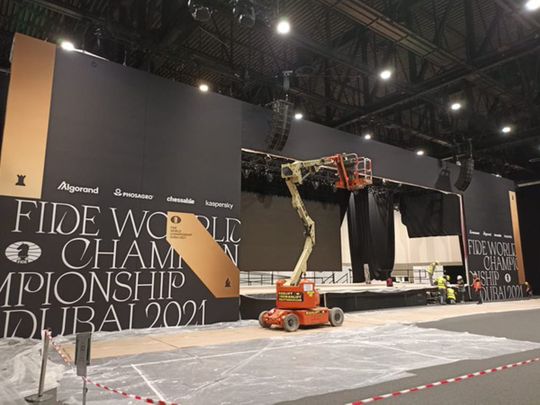
Dubai: The attention of the chess world will be rivetted to Hall 2 of the South Wing of Dubai Exhibition Centre, at the entrance of Expo 2020 Dubai, from Friday. Magnus Carlsen, arguably the greatest chess player of this generation, will be defending his Fide world crown for the fifth time against Russian Grandmaster Ian Nepomniachtchi in the Fide World Championship match here for a period of three weeks till December 16.
A visit to the venue on Monday did not quite reveal the sense of the buzz - with the security personnel at the gate refusing a peek at the hall - saying ‘lot of work’ was in progress inside. All that could change from Wednesday (when the opening ceremony takes place while Round 1 is on Friday) as the sizeable chess playing fraternity of the UAE, along with writers of the game from all around the globe, would be converging there while the rest of the world will be watching the moves online.
The Carlsen–Nepomniachtchi showdown had been billed as one the marquee sporting events lined up as part of Expo 2020. Commenting on the relevance of the match being a part of Expo, Mohammed Al Ansaari, Vice President – Communications at Expo 2020 Dubai, had said: “Expo Dubai will be a global celebration of the very best of humankind, held in one of the world’s most welcoming and ambitious nations – what better place to host a thrilling showdown between the brightest minds in chess?”
Welcoming the idea of hosting the contest on the sidelines of Expo 2020, Carlsen told Gulf News in an interview earlier this month: ‘‘I think organizing the World Championship match in chess at the Expo 2020 is a very good idea. With hundreds of thousands of daily visitors to Expo 2020 and the relatively broad global coverage of the World Championship match digitally, I hope the execution of the match will bring out synergies for both Expo 2020 and for the chess world.’

The sense of pride in Mohammed Abdul Ghani Alhallak, a Fide arbiter and Executive Director of Fujairah Chess & Culture Club, in the UAE hosting an event of this magnitude was palpable. ‘‘The UAE’s affinity for chess goes very deep as we have hosted several world class events in Dubai, Abu Dhabi, Al Ain and Fujairah. Talking about the match, I will rate Carlsen as the sharpest mind in the game and think that he will be able to defend his title against Nepomniachtchi,’’ AlHallak said.
The organizers have announced a hefty two million euros prize fund, which will be split 60 percent for the winner and 40 percent for the runner-up. This is a substantial increase from the one million euros in the 2014, 2016 and 2018 World Chess Championships, but still a lower amount than the 2013 World Chess Championship where the players shared 2,65 million euros.
The 2013 Worlds, which saw Carlsen beating India’s iconic chess player Viswanathan Anand to claim the world title for the first time, holds the record for highest viewership in the history of chess. The Norwegian had subsequently defended his title in 2014, 2016 and 2018 editions.
Match format
The Carlsen – Nepomniachtchi 2021 match will have an extended format. Instead of the 12 games that were traditionally played in the past decade, this match will feature 14 games. In case the result is equal after Game 14, tie-breaks will follow.
Inside the mind of Magnus Carlsen: ‘I am
happy to win in any way possible’

Sean Ingle in Dubai
@seaningle
Wed 24 Nov 2021 19.01 GMT
“I’m less hungry. I think you’re always going to be if you’re playing for the world title for the fifth time, rather than the first.” It is quite the opening gambit from Magnus Carlsen, in his final newspaper interview before he puts his crown on the line again. But sport’s deepest thinker is merely revving up before he truly opens up.
Carlsen has long established himself as the greatest chess player of his generation. Perhaps any generation, given he is the highest-rated of all time and has held the Fide world title since 2013. But there is something else that marks the Norwegian out in an era where sporting superstars are increasingly bland and on brand: his unflinching honesty.

Chess: Magnus Carlsen and Ian Nepomniachtchi face off for $2m in Dubai
Many world champions would take umbrage when asked if the fire still rages as intensely as it once did. Especially if it was on the eve of their next major encounter. Carlsen, though, sees it as the starting point for a discussion – and a confession.
“I’ve been a chess professional for a long time,” he replies. “So I think my base motivation is going to be a little bit lower than it was. But the question is really whether I can raise it for important events. That’s what I put my emphasis on. And that’s what I’ve always managed to do.”
He pauses. Casts his mind forward to the challenge of facing the talented but unpredictable Russian Ian Nepomniachtchi over three gruelling weeks. Makes another confession.
“Right now, I don’t really feel it,” he admits. “I feel like I’ve been here, done it before. And it doesn’t excite me, to be honest. But I think when I sit down on Friday, it will feel very different. And I’m very, very much looking forward to that.”
That directness is as discombobulating as any move the 30-year-old might play on the board here in Dubai. With anyone else, such comments would serve as a giant red flag. Instead it feels like more evidence of the unique workings of Carlsen’s mind.
His younger sister Ingrid tells the Guardian that as a very young child he would play with Lego for hours without losing concentration, which his family sensed was unusual. “Later it was the same with chess,” she says. “Magnus was always sitting by the table when we were eating dinner. He usually had his own little table with a chessboard. He would sit there for five hours after school, just training. My parents would have to force him to go to sleep because he wanted to keep on learning.”
My biggest advantage is that I am the better chess player
One of his best friends, Askild Bryn, remembers Carlsen glancing at a game of his at a youth chess tournament when he was 10 or 11. “He looked just for a second or two,” he says. “But afterwards when I was analysing, he came up to me and said: ‘You should have played this and this with a series of variations.’ That’s when I realised he was special.”
Shortly afterwards Carlsen played Nepomniachtchi - who is four months older – for the first time at the European under-12 youth championships. Carlsen lost that game. And then the next one. And the one after that. And while he eventually went on to surpass his early rival, it is an intriguing subplot of their 14-game encounter that – even now – Nepomniachtchi still holds a 4-1 lead in classical chess.
Not that Carlsen sees it as a factor. “I wouldn’t put too much emphasis on that,” he says, flicking his hand dismissively. “If that gives him some confidence, good for him.”
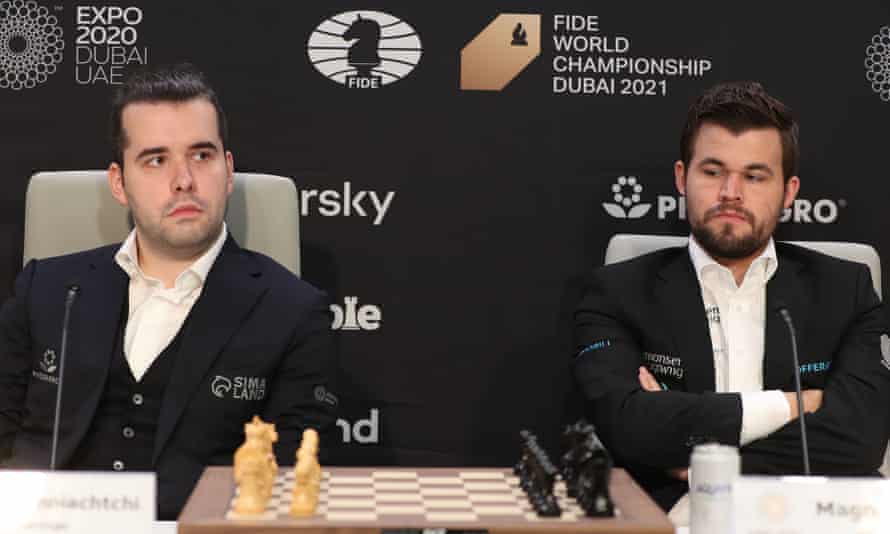
Advertisement
The pair are friends. Or at least as friendly as any rivals can be when they are fighting over a world title and a purse of £2m, with 60% going to the winner. A decade ago, Nepomniachtchi briefly worked with Carlsen, and there is a clear respect between the two. However, that respect goes only so far.
When Carlsen is asked about the importance of momentum in chess, and his opponent’s tendency to sometimes go on tilt after a bad defeat, he nods his head. “It remains to be seen, of course, if Ian will be more resilient than he has been in the past if he is down,” he says, smiling. “Hopefully I can put him in that situation. That will be my main achievement.”
Then comes another subtle twist of the knife. “I’ve said it before, but the biggest advantage is that I am the better chess player,” he says. “There’s a lot of evidence, over the last few years, about the strength of the best players in the world.
Having said that, it doesn’t really matter for this match. There’s a famous quote: It’s not enough to be a good chess player. You also have to play well.”
The Guardian view on a chess renaissance: it’s not black and white
Carlsen, of course, does that better than anyone. His rating is 2855, more than 50 points higher than Ding Liren in second, and well clear of Nepomniachtchi, who is fifth in the world on 2782. So why is he so much better than everyone else? Carlsen himself refuses to speculate, saying: “It’s for my opponents to figure out.”
But Vladimir Kramnik, who held the world title from 2000 to 2007, makes a compelling case that comes down to two key factors: Carlsen’s psychological mindset and his broad talent. “Magnus is the only player in the world for whom there is no other option than winning,” says Kramnik.
“It is very deep in the head. Others want to win. But Magnus? He needs to win. That is a very big difference. For him there is no second place. And that gives a lot of additional force when you play chess.”
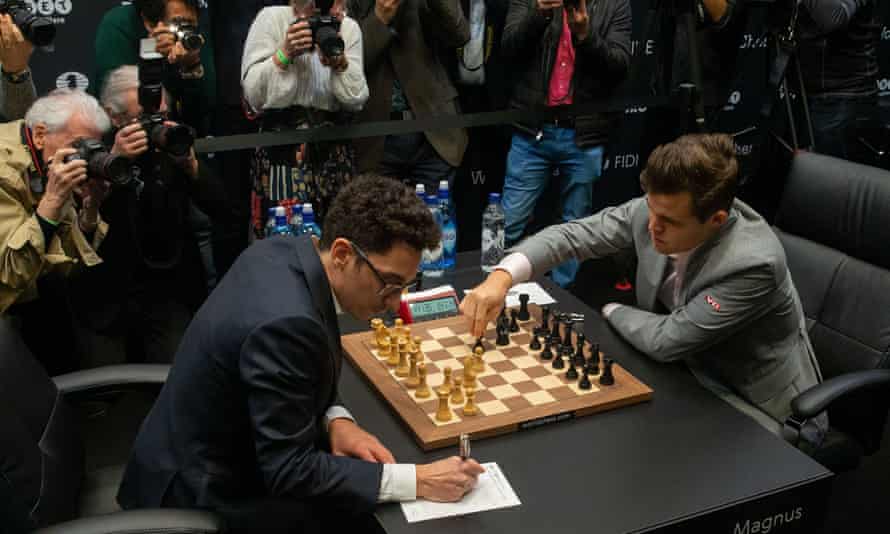
It sounds like Tiger Woods in his prime. But Kramnik cites another key factor: that Carlsen has a deeper understanding of strategy than his contemporaries. “There was a very significant change when computers appeared,” says the 46-year-old Kramnik. “My generation, which grew up before computers, have a strong general understanding of the game strategically. But our calculation abilities are a bit worse than most of the young generation.
“But while the younger generation all have fantastic calculation and imagination, from time to time, practically every player at the top will make quite serious strategic mistakes. Yet Magnus is able to calculate really well and he has this old-school strategic base, no worse than the great players of the past like Anatoly Karpov. So he can do both.”
Another factor is that Carlsen is happy to grind away for hours on end, even in the most lifeless of positions: setting his opponent problems, asking nasty questions, preparing to pounce if he detects a weakening of the defensive shield. It often works, too.
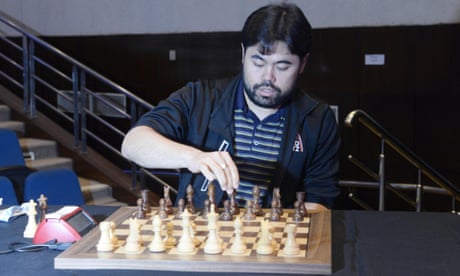
Chess: Nakamura swaps barbs with Carlsen after 27-game unbeaten run
Yet in his past two world championship matches, against Sergey Karjakin in 2016 and Fabiano Caruana in 2018, Carlsen has only been able to impose his will in tiebreaks after the classical section of their matches were drawn. Does he intend to make a statement in Dubai with a thumping victory, or is he prepared to win ugly?
“I am happy to win in any way possible,” he replies. “I’m somebody who puts more emphasis on the sporting aspects of chess than the artistic. And even more so during world championship matches. It’s about getting results. Because only one result matters and only one result is acceptable. But I won’t be aiming for a tiebreak in any way. And the increase to 14 games is good for me because it decreases variance.”
Over the past 18 months, chess has become a serious esport with Carlsen’s Play Magnus Group one of the major players. Among its successes has been a hugely successful online tour, which has attracted all the top players and sponsorship from major companies, including Mastercard.
However, Carlsen says he is content to let people he trusts run it, rather than get too involved in the day-to-day. “I’m a chess player who also has business interests,” he says. “But that is my own philosophy and it’s also the philosophy of the company. My most important job is to be the best that I can be at the chessboard. Everything else comes a distant second.”
It is why, despite his motivation occasionally waning, the world champion has been working hard on his body and mind – ready, once more, to prove he is still the supreme ruler of the game of kings. “We have had training camps with a pretty intense regimen to get ready,” he says. “The analogy with boxing is a very obvious one. But it’s also obvious because it’s quite apt.”
Not surprisingly, Carlsen is aiming for a knockout once more.
An opinion columnist recently argued that to save Earth, society will need "a few more Greta Thunbergs," but "a lot more Elon Musks." That would have the opposite effect.
Commentary by Dr. Warren J. Blumenfeld Sunday, November 21, 2021
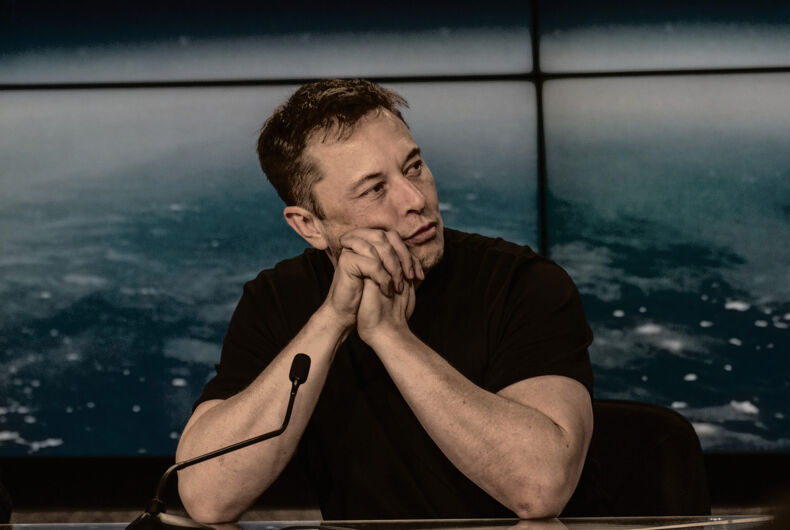
SpaceX and Tesla CEO Elon Musk at the SpaceX Falcon Heavy Flight 1 post launch press conference on February 6, 2018Photo: Daniel Oberhaus/Wikimedia Commons
In his New York Times editorial commentary, published on November 16 and entitled, “Want to Save the Earth? We Need a Lot More Elon Musks,” reporter and opinions columnist Thomas Friedman argues that capitalist entrepreneurs, who connect with valid and reliable scientific methodologies and research, can solve the problems of climate change plaguing our planet.
While he values grassroots activists and acknowledges that “we need a few more Greta Thunbergs,” Friedman contends that we also need “a lot more Elon Musks” to do so. Evidence of Musk’s commitment to environmentally harmful business practices and wealth hoarding, though, show otherwise.
Related: Billionaire Richard Branson’s space flight was expensive. You paid the cost & didn’t know it.
Friedman acknowledges that the capitalist system has previously contributed to the problem, as government have granted large subsides to petroleum companies to extract toxic chemicals from the ground, which has resulted in the human-made global crisis that jeopardizes all life on the planet.
He, therefore, promotes the prospect that if “we can begin to reshape capitalism” itself to halt and potentially reverse the Earth’s environment and climate to a more natural state by what Friedman refers to as “the best of American capitalism.”
“We will get there only when Father Profit and risk-taking entrepreneurs produce transformative technologies that enable ordinary people to have extraordinary impacts on our climate without sacrificing much — by just being good consumers of these new technologies,” Friedman wrote.
He continued: “We need to re-energize our innovation ecosystem to where government funds basic research that pushes the boundaries of physics, chemistry and biology and then combines that innovation with immigration policies that amass the world’s best pools of engineering talent and then unleashes that talent — propelled by risk-takers — to invent new clean technologies to slow global warming at the warp speed and scale we need.”
While this is all well and good, Friedman’s “reshap[ing of] capitalism” does not go deep enough and far enough. He fails to interrogate the massive wealth inequality that accrues enormous benefits to the mega corporations and the few multi-billionaires like Elon Musk. This system inhibits the entry of the talented who lack financial resources from engaging in this risk-taking entrepreneurship.
While the economy has done extremely well for the super-rich lately, household incomes have hardly grown or have grown only modestly for the majority of residents of the U.S. this century. There are numerous reasons as to why: massive technological changes that have rendered human labor obsolete, the decline of labor unions, the eroding value of the minimum wage, and globalization, which often diverts jobs overseas.
Regarding the top 5% of wage earners, their incomes have jumped over the same period. The Pew Research Center found that “Upper-income families were the only income tier able to build on their wealth from 2001 to 2016, adding 33% at the median. On the other hand, middle-income families saw their median net worth shrink by 20% and lower-income families experienced a loss of 45%.”
In the United States, the top 1% of the population has accumulated an estimated 34.6% of the wealth. The next 9% of the top earners accumulated an estimated 38.5%, while the remaining 90% of the nation accounted for a combined accumulation of only 26.9%.
The top financial rewards went only to 400 people, increasing wealthy earners’ combined income in 2020 during the pandemic to $3.2 trillion dollars, an increase of $240 billion from 2019. These same 400 people accumulated more wealth than the lower 50% of the American population combined.
Some families have the privilege of purchasing two, or three, or four, or five, or even six homes — that they occasionally visit depending on their current mood, like the rest of us choose which pair of underwear to wear for the day. Meanwhile, many of our people, including youth, go homeless.
Let’s dive into Musk and his business practices, since Friedman specifically singled him out. Take this into consideration, as reported by ProPublica: “Musk, who had an actual taxable income of $1.52 billion during the five-year period, paid no federal income taxes in 2018.”
We can evaluate his efforts to save our planet from the destructive effects of climate change, but I must warn you, though, you will need to don your toxin-resistant full-body suits and gas masks.
Let us look first into his SpaceX Starship spacecraft. Darrell Etherington of TechCrunch posed questions about them to Musk in a Twitter interview. Musk stated “that the spacecraft is being designed with the plan of flying it for an average of three flights per day, each carrying over 100 tons of payload per flight, for a total of more than 1,000 flights per year, per vehicle.”
In the same interview, Musk mentioned that he is planning to build a fleet of 1000 of these space vehicles by the end of this decade.
According to the Energy Consulting Group, each SpaceX starship and booster launch will require approximately 1000 tons of methane in the form of liquified natural gas. “This works out to be about 150 mmscfd per Starship, or about 150 billion cubic feet of methane/natural gas per day (bcfd) for a fleet of 1000 rockets. 150 bcfd of natural gas is roughly equivalent to 25 million barrels a day of oil,” the group found. “…In essence, Mr. Musk is suggesting that US demand for natural gas could grow dramatically over the next 10 or so years due to SpaceX activity.”
For Musk’s Tesla automobiles, he has announced an agreement with Glencore, one of the largest global commodity trading firms, to purchase cobalt from the Democratic Republic of Congo for Tesla lithium-ion batteries. Though Musk has plans one day to use safer materials for his batteries, present reports indicate that exposure to pollutants from these cobalt mines substantially increases the risks of serious birth defects in children including limb abnormalities and spina bifida.
In addition, Musk has priced his cars out of the reach of people with moderate incomes, and he maintains non-union plants. This is certainly no way to “restructure capitalism.”
Thanks largely to his SpaceX division, Musk could potentially become the world’s first trillionaire, which would additionally expand the income and wealth gap.
So yes, we see a redistribution of wealth in the United States — but certainly not in equitable ways. Workers create goods and services through labor that is detached and alienated from their personal lives and personal interests, thereby amassing inordinate wealth for the owners and executives.
Few actually “succeed” when millions of people have been shut out of the economy. Few actually “succeed” when people do not have the money to spend on the goods and services in the stores owned and managed by the rich.
Rather than look to mega corporations and billionaires like Musk to get us out of the climate crisis through the inherently flawed system of monopoly capitalism, we must make our tax system more equitable. As the system now exists, taxpayers are subsidizing the rich to build and promote their creations at the expense of the rest of us.
Several Democrats in Congress, including Sens. Bernie Sanders (I-VT), Elizabeth Warren (D-MA), and Ron Wyden (D-OR) have proposed increasing taxes of the super-rich.
Sanders and Warren have called for a 3% total annual tax on wealth exceeding $1 billion and a 2% annual wealth tax on the net worth of households and trusts from $50 million to $1 billion.
The chance of such a “wealth tax” actually passing into law is virtually nil to none, owing to the lobbying and payoffs of the super-rich to their legislative puppets in Congress.
Yet Musk, who maintains the highest net wealth of anyone worldwide, staunchly resists paying his fair share in taxes.
When Sanders tweeted that “we must demand that the extremely wealthy pay their fair share. Period,” Musk was so offended by the notion that he offensively responded, “I keep forgetting that you’re still alive,” and claimed “Sanders is a taker, not a maker.”
I agree with Thomas Friedman that we must “reshape capitalism.” But I do not wish to see any more Elon Musks, or Bill Gateses, or Richard Bransons, or Jeff Bezoses, or any more billionaires polluting space.
I want, instead, to see real opportunities for anyone who has the talent and desire to create more partnerships between themselves and companies with science. I want to see a fairer and more equitable tax system.
Let us then truly “reshape capitalism.” But we’ll need a lot more Greta Thunbergs and far less Elon Musks to do so.

Oil rig. Photo courtesy of Pixabay/Pexels (CC0)
By Johnna Crider
I’ve seen quite a few vehement Twitter posts regarding Elon Musk, Tesla, subsidies, that 2008 government loan in which Tesla repaid American taxpayers back early and with interest as of late. Politicians and political talking heads have been taking to Twitter to discuss the woes of the villain, Elon Musk, and the wealth that he “stole from poor people.”
They point to Elon’s wealth and government subsidies for Tesla and SpaceX. Although the latter isn’t a clean energy company and uses fossil fuels like all aerospace companies, SpaceX has saved taxpayers millions of dollars with its reusable rockets and by offering by far the lowest cost to send NASA astronauts and equipment to space. It should also be noted that Elon Musk is in favor of a carbon tax, which he stated before would hurt SpaceX. This is often overlooked.
That aside, the target shouldn’t be on Elon Musk. It should be on the fossil fuel industry. The governments of the world are giving the fossil fuel industry $11 million in subsidies per minute.
Earlier this year, Greenpeace noted that the American government gives away $20 billion a year in taxpayer money to the fossil fuel industry. The article pointed out that the US government has subsidized coal, oil, and gas for decades even though the majority of voters want to end these subsidies.
$11 Million A Minute Given Away By Governments To Big Oil, Gas, & Coal
The fossil fuel industry is sucking up billions globally each year and is destroying our planet. The Guardian reported that according to the International Monetary Fund (IMF), the fossil fuel industry receives $11 million in government subsidies every minute. The production and burning of coal, oil, and gas were subsidized by $5.9 trillion in 2020.
Furthermore, not a single country has priced its fuels to reflect its full supply and environmental costs. The subsidies, experts told The Guardian, are adding fuel to the fire of the climate crisis during a time when we need rapid reductions in carbon emissions. IMF analysts pointed out that governments setting fossil fuel prices that reflect their true costs would cut worldwide CO2 emissions by over a third — a big step toward meeting the internationally agreed upon 1.5°C average warming target.
Maria Pastukhova, of the think tank E3G, said it best:
“The IEA’s net-zero roadmap projects that $5tn is necessary by 2030 to put the world on the pathway to a climate-safe world. It is maddening to realize the much-needed change could start happening now, if not for governments’ entanglement with the fossil fuels industry in so many major economies.
“Fossil fuel subsidies have been a major stumbling block in the G20 process for years.”
Focus On The Fossil Fuel Subsidies
Before worrying about Elon Musk, Tesla, and how much money Elon has, focus on this massive problem and backroom dealings with the fossil fuel industry.
Instead of focusing on Elon Musk’s wealth made his first few millions, to hide the fact that our system is handing out trillions to an industry that is killing us.
They point to Elon Musk and demand that he end world hunger, solve poverty, and fix a broken system.



